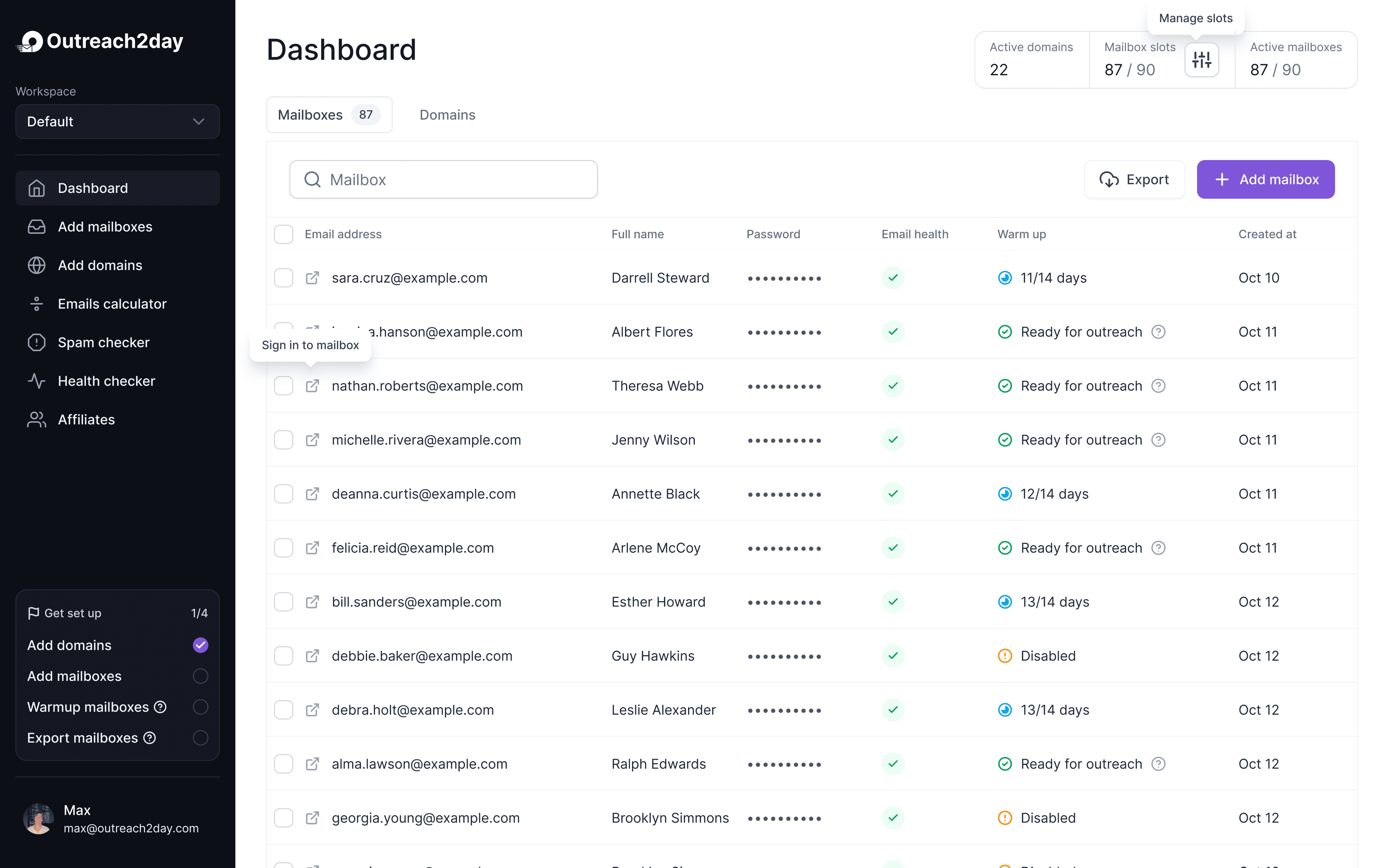Mastering Your Spam Test Score to Boost Deliverability
Oct 2, 2025

Think of a spam test score as your email’s reputation score. It’s a number or a grade that predicts whether big-time email providers like Gmail and Outlook will trust your message or toss it straight into the junk folder. A good score means you look like a legitimate sender. A bad score? That’s a massive red flag.
What Is a Spam Test Score and Why It Matters
Before sending a campaign, conducting a spam test is akin to a quick check-up for your email. This test examines technical setup, content, and sender history to identify potential issues by simulating the filters used by major inbox providers.
The resulting score indicates how well your email will perform against spam filters. These filters are crucial as almost half of global emails are spam, with the U.S. receiving 8 billion and China 7.6 billion spam emails daily. More details can be found in Mailmodo's research.
Impact on Campaign Success
A poor spam score directly undermines your marketing efforts:
Declining Open Rates: Emails not landing in the primary inbox remain unseen, killing engagement metrics.
Effort Wasted: Emails in spam represent wasted time, creativity, and money.
Reduced ROI: Poor deliverability results in fewer clicks, leads, and sales, diminishing your email marketing investment.
Importance of Sender Reputation
Your spam score reflects your sender reputation, affecting how inbox providers perceive your domain and IP. A consistently low score marks you as a risky sender, leading to more aggressive filtering.
Maintaining a strong sender reputation requires smart, responsible sending practices. One poor campaign can harm your reputation, complicating future inbox delivery.
Monitoring your spam test score safeguards the long-term health of your email channel, ensuring your messages are seen.
Spam Score Factors at a Glance
Authentication Records
✔ SPF, DKIM, DMARC = trust signal. Missing = suspicious.Content & Formatting
✔ Avoid spammy words, ALL CAPS, messy HTML.Sender Reputation
✔ Your long-term “report card.” Hard to fix once damaged.Blacklist Status
✔ If listed → direct to spam/junk. Check & delist.Engagement History
✔ Opens, clicks, and complaints show if users value your emails.
📌 Together, these define your email trust & inbox placement.
Decoding Your Score With Technical Authentication
Technical email authentication acts as a digital passport for your emails. When you send a message, the receiving server verifies your identity. Without proper credentials, your email may end up in the junk folder. This is where SPF, DKIM, and DMARC are essential.
These three authentication methods are crucial for a good spam test score, as they establish trust with inbox providers. Here's a quick overview of how each one protects your sender identity.
SPF: Domain Guest List
Sender Policy Framework (SPF) serves as a guest list for your domain. It specifies which IP addresses are authorized to send emails on your behalf. If the sending IP matches your SPF record, you pass the first verification step. If not, it's a major red flag that can harm your spam score.
DKIM: Digital Wax Seal
DomainKeys Identified Mail (DKIM) acts like a tamper-proof seal, ensuring your email is genuinely from your domain and unaltered. Each message includes a unique digital signature that receiving servers use to verify authenticity and integrity. A missing or broken DKIM signature signals potential fraud to spam filters.
These factors, combined with your content and reputation, influence your email's final score.

As you can see, technical authentication is the bedrock. Everything else—your content, your sender history—is judged on top of it.
DMARC: The Security Policy for Your Kingdom
Finally, we have Domain-based Message Authentication, Reporting & Conformance (DMARC). If SPF is the guest list and DKIM is the wax seal, then DMARC is the official security policy telling the guards exactly what to do when an unauthorized person tries to crash the party.
DMARC instructs receiving servers on how to handle emails that fail either SPF or DKIM checks. You get to set the rules:
None: Take no action, just monitor the failures.
Quarantine: Send the sketchy emails to the spam folder.
Reject: Block the emails from being delivered at all.
Implementing a DMARC policy is a powerful move. It tells inbox providers that you're serious about email security and are actively stopping anyone from spoofing your domain. Spam filters love to see this proactive approach.
At the end of the day, these three protocols aren't just technical boxes to tick. They are the absolute foundation of your sender reputation. A spam test will instantly penalize you for missing or misconfigured records because it’s the clearest sign of an amateur—or worse, a malicious sender. Nailing your SPF, DKIM, and DMARC is the single most important technical step you can take to boost your spam test score and make sure your messages land safely in the inbox.
How Email Content and Infrastructure Affect Your Score
Email Authentication and Content Quality
Technical setups like SPF and DKIM serve as your email's passport, ensuring passage to the inbox border, but not guaranteeing entry. Entry is determined by the content and the reputation of your sending infrastructure. Ultimately, your spam test score depends on your email's content and the historical performance of your sending infrastructure. Spam filters act as digital detectives, analyzing every aspect of your email. If it resembles spam, it will be treated as such, regardless of perfect technical records.
Importance of Email Content
Your email content forms the first impression. Spam filters are adept at identifying elements linked to junk mail, such as messy formatting or aggressive sales language. Even with good intentions, it's easy to trigger these filters. Small details, like a subject line in all caps or using words like "URGENT," can significantly impact your spam test score.
To avoid spam filters:
Avoid Trigger Words: Phrases like "Free" or "Winner" are red flags.
Balance Images and Text: Avoid emails that are just one large image.
Maintain Clean HTML: Complex or broken code can raise suspicions.
Focus on providing genuine value rather than aggressive sales pitches. A helpful tone usually outperforms a desperate one.
In B2B work, a professional, personalized message is crucial. Practical advice on cold outreach can prevent alarm triggers.
Sender Reputation as Your Digital Resume
Beyond individual emails, your sender reputation—attached to your domain and IP—affects inbox placement. A good sender reputation is built over time through consistent habits. Poor campaigns can damage it, affecting deliverability for months.
Key reputation metrics include:
Spam Complaint Rate: Being marked as spam is a significant negative signal.
Bounce Rate: High hard bounce rates indicate poor list maintenance.
Blacklist Status: Association with spam can lead to blocklist inclusion.
Infrastructure's Impact on Your Score
The infrastructure used to send emails affects your reputation. Shared IPs with spammers can lower deliverability, even if your content is clean. Your spam score reflects both your content and long-term habits. Crafting valuable content and managing a healthy infrastructure are both vital to inbox placement.
After receiving a spam test report, transform the scores into an action plan. Addressing issues is akin to a car diagnostic check, indicating necessary fixes.
Understanding and Improving Your Score
Spam testing tools provide a quick health check. Scores are generally categorized as:
Excellent (8-10): Minimal issues.
Good (5-7): Minor improvements needed.
Poor (0-4): High risk of being flagged as spam.
Tools like Mail Tester offer summaries highlighting urgent issues.
Analyzing Report Sections
Spam test reports break down into sections covering:
Authentication Checks: Verifying proper setup of SPF, DKIM, and DMARC.
Content Analysis: Scanning for spam triggers.
Blacklist Status: Checking for blocklist entries.
Server and Infrastructure Health: Technical configurations.
Treat your report as a checklist. Address critical issues like authentication failures first, then tweak content as needed.
From Diagnosis to Action
Interpreting your spam score helps protect deliverability. A clean spam report is crucial. Review results, prioritize fixes, and improve sender reputation for better outcomes.
Steps to Enhance Your Spam Test Score
A poor spam test score can be enlightening, revealing what needs fixing. Consider it a guide to improving delivery.
Strengthen Technical Foundations
Ensure proper email authentication with SPF, DKIM, and DMARC. Spam filters are strict, and authentication is essential to avoid the junk folder.
SPF: Specifies authorized sending servers for your domain.
DKIM: Adds a digital signature verifying email integrity.
DMARC: Dictates actions for emails failing SPF/DKIM checks.
Authentication is crucial, especially as phishing threats rise.
List Hygiene and Engagement
Maintain a clean, engaged email list. Remove invalid addresses and ensure unsubscribe links are visible to prevent spam complaints.
A small, engaged list is more valuable than a large, disengaged one.
Refine Email Content and Structure
Craft human-sounding emails, avoiding spam triggers like "Free" or "Urgent." Avoid excessive exclamation points and use a balanced text-to-image ratio. Collaborate with a reputable ESP to enhance deliverability.
Finally, work with a reputable email service provider. A good ESP protects its IP reputation and provides tools to keep you out of the spam folder.
Spam Score Improvement Checklist
Authentication
✔ Set up SPF, DKIM, and DMARC correctly.Domain Reputation
✔ Check blacklists (e.g., Spamhaus) and request delisting if needed.List Hygiene
✔ Remove invalid emails and hard bounces.Email Content
✔ Avoid spammy words, ALL CAPS, and excessive punctuation.Email Structure
✔ Balance text and images; add alt-text to all images.Links & Tracking
✔ Use full, working links from your domain (no shorteners).
🔑 Fixing these step by step = better spam score + stronger deliverability.
Common Questions About Spam Test Scores
Understanding a spam test score and its implications can clarify email deliverability strategies. This guide offers quick solutions for common issues, transforming test insights into a robust email program.
Spam Test Frequency
Frequency depends on your sending habits. Always test before launching major campaigns or new templates to preemptively catch issues. Monthly tests are advisable for frequent senders to monitor sender reputation and adapt to spam filter changes. If engagement drops suddenly, conduct an immediate spam test to identify issues like blacklisting or content problems.
Achieving a Perfect Spam Test Score
While a perfect 10/10 is ideal, consistently high scores are more crucial for maintaining a good sender reputation. Different tools have varying criteria, so focus on resolving significant issues like authentication failures, blacklist listings, broken links, or improper text-to-image ratios. A consistent 8/10 or higher is more beneficial than a one-time perfect score.
Spam Score vs. Deliverability
A spam test score predicts potential spam flagging, much like a weather forecast. Deliverability indicates actual outcomes, such as inbox placement or bounces. A good score enhances deliverability chances but doesn’t guarantee it.
Impact of Shared IP Addresses
Using a shared IP ties your reputation to others on that IP. Poor practices by others can negatively affect your score and deliverability. Good ESPs monitor shared IPs, but high-volume senders should opt for a dedicated IP address for better control.
For further email marketing insights, visit the Outreach Today blog.
Ready to stop worrying about deliverability and start building a high-performance outreach machine? Outreach Today automates your entire email infrastructure, from domain setup and DNS configuration to automatic mailbox warm-up. Get dozens of high-deliverability inboxes ready to go in minutes, not hours, and ensure your messages always land in the inbox.
Take control of your outreach at https://outreach2day.com.
Setup your outreach in
3 minutes. Literally.
Add or transfer domains from other platforms, set up mailboxes, and initiate warming or export processes

